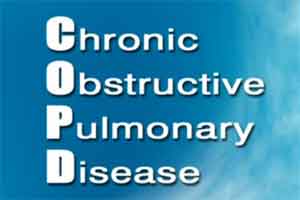- Home
- Editorial
- News
- Practice Guidelines
- Anesthesiology Guidelines
- Cancer Guidelines
- Cardiac Sciences Guidelines
- Critical Care Guidelines
- Dentistry Guidelines
- Dermatology Guidelines
- Diabetes and Endo Guidelines
- Diagnostics Guidelines
- ENT Guidelines
- Featured Practice Guidelines
- Gastroenterology Guidelines
- Geriatrics Guidelines
- Medicine Guidelines
- Nephrology Guidelines
- Neurosciences Guidelines
- Obs and Gynae Guidelines
- Ophthalmology Guidelines
- Orthopaedics Guidelines
- Paediatrics Guidelines
- Psychiatry Guidelines
- Pulmonology Guidelines
- Radiology Guidelines
- Surgery Guidelines
- Urology Guidelines
Potential new treatment combats COPD and other lung diseases

New research published online in The FASEB Journal reveals a potential drug to combat the life-threatening effects of chronic obstructive pulmonary disease (COPD). Specifically, the study investigated the efficacy of a receptor for advanced glycan end-products (RAGE)-specific antagonist chemical compound, FPS-ZM1, in mice, and found that this compound reverses the inflammatory response and has a protective role in COPD.
"RAGE disturbances in pulmonary disorders are precise and effective strategies with beneficial clinical effects," said Se-Ran Yang, D.V.M., Ph.D., a researcher involved in the work and an associate professor at the Department of Thoracic and Cardiovascular Surgery in the School of Medicine at Kangwon National University in Gangwon, Korea. "Blockade of RAGE as a novel clinical therapeutic for COPD ameliorates emphysema/COPD development and progression."
In their study, Yang and colleagues investigated the efficacy of RAGE-specific antagonist FPS-ZM1 administration in both in vivo and in vitro COPD models to determine the molecular mechanism by which RAGE influences COPD. The researchers injected mice with an in vivo COPD inducer and the RAGE antagonist FPS-ZM1. Then they assessed the infiltrated inflammatory cells and their production of cytokines. Cellular expression of RAGE, initiating inflammatory response, and soluble RAGE, acting as a "decoy," was determined in protein, serum, and bronchoalveolar lavage fluid in the mice, as well as in the serum of human donors and patients with COPD. They analyzed downstream damage-associated molecular patterns (DAMPs) and danger signals in vivo and in vitro and in patients with COPD, and found that RAGE was associated with the up-regulation of DAMP-related signaling pathways via Nrf2 (a master regulator of the total antioxidant system in humans). FPS-ZM1 administration also significantly reversed emphysematous lung symptoms in mice.
"No one expected the pathogenic roots of COPD to be simple, and this study gives us an indication of the complexity involved.," said Thoru Pederson, Ph.D., Editor-in-Chief of The FASEB Journal. "The current pharmacological armamentarium is limited, and studies like this are thus extremely valuable as a foundation."
You can read the full Article by clicking on the link :
Hanbyeol Lee, Jeong-Ran Park, Woo Jin Kim, Isaac K. Sundar, Irfan Rahman, Sung-Min Park, Se-Ran Yang. Blockade of RAGE ameliorates elastase-induced emphysema development and progression via RAGE-DAMP signaling. The FASEB Journal, 2017; fj.201601155R DOI: 10.1096/fj.201601155R

Disclaimer: This site is primarily intended for healthcare professionals. Any content/information on this website does not replace the advice of medical and/or health professionals and should not be construed as medical/diagnostic advice/endorsement or prescription. Use of this site is subject to our terms of use, privacy policy, advertisement policy. © 2020 Minerva Medical Treatment Pvt Ltd